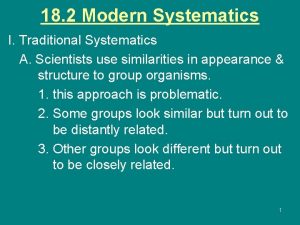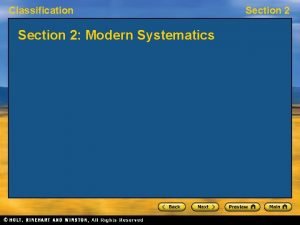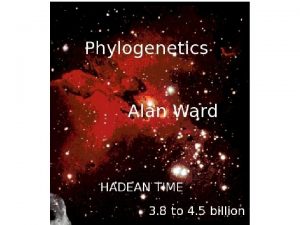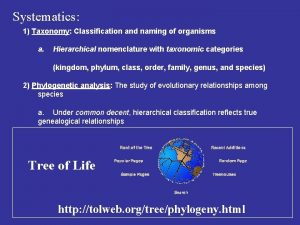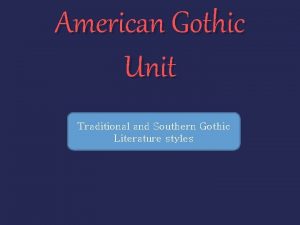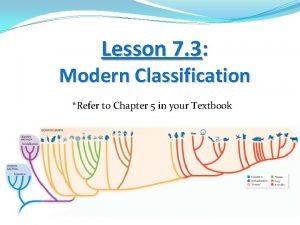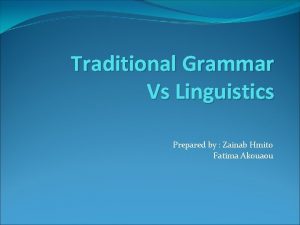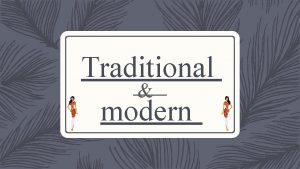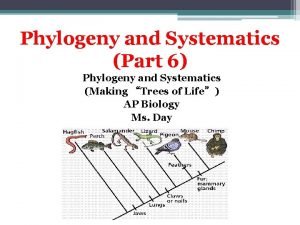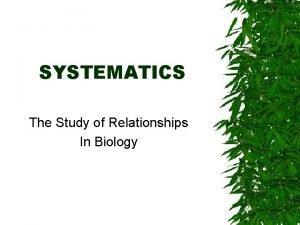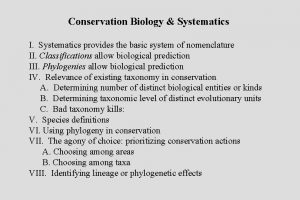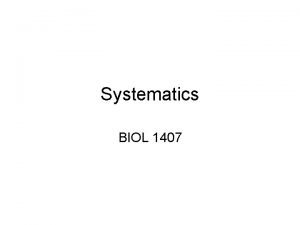18 2 Modern Systematics I Traditional A Scientists








- Slides: 8

18. 2 Modern Systematics I. Traditional _______ A. Scientists use similarities in ______ & ______ to group organisms. 1. this approach is ______. 2. Some groups look ______ but turn out to be _______ related. 3. Other groups look _____ but turn out to be ________ related. 1

II. Phylogenetics A. Def – The study of the ______ relationships between _____. B. It’s like trying to draw a huge family ____ over millions of ________. C. Not all similar ______ are inherited from a common _______. 1. Ex. -_______ of an insect & the _______ of a bird. D. _______ evolution = similarities in groups that are _____ closely related. 2

2. ______ characters = Similarities that arise through _______evolution. E. This family tree, or _____ tree, represents a hypothesis of the relationships between ______ groups. III. ________ A. Objective method that unites _______ with ________. 1. Focuses on finding _______ that are shared between ______ groups because of shared ________. 3

2. Ancestral character is defined as having evolved in a common ____ of _____ groups. 3. ______ character = one that evolved in ____ group but ______ the other. C. Constructing a Cladogram 1. A _____ is a phylogenetic tree that is drawn in a ______ way. 2. A ______ is a set of groups that are related by descent from a single ancestral ______. 3. Outgroup = group that lacks some of the shared __________. 4

5

IV. Inferring Evolutionary Relatedness A. ________ 1. refers to the ______ structure or ______ of organisms. 2. Organisms that share ancestral genes often show similarities during ________. B. Molecular Evidence 1. Scientists now use _____ info. to infer phylogenies. 2. DNA _______ in a _______ is determined for several species 3. Then, each letter at each position is ______. 6

7

C. Evidence of Order and Time 1. Cladistics can determine only the relative _______ of divergence, or ______, in a phylogenetic tree. 2. The ____ record can often be used to infer the actual _______ when a group may have begun to “branch off. ” D. Inference Using _______ 1. This principle holds that the _____ explanation for something is the most ______, unless strong evidence exists _____ that explanation. 2. Given two possible cladograms, the one that implies the _____ character changes between _____ is preferred 8
 Traditional systematics
Traditional systematics Section 2 modern classification
Section 2 modern classification Systematics deals with
Systematics deals with Systematics vs taxonomy
Systematics vs taxonomy Synapomorphy
Synapomorphy Modern gothic literature vs traditional gothic
Modern gothic literature vs traditional gothic Traditional linguistics and modern linguistics
Traditional linguistics and modern linguistics Traditional classification vs modern classification
Traditional classification vs modern classification Strengths and weaknesses of traditional grammar
Strengths and weaknesses of traditional grammar
